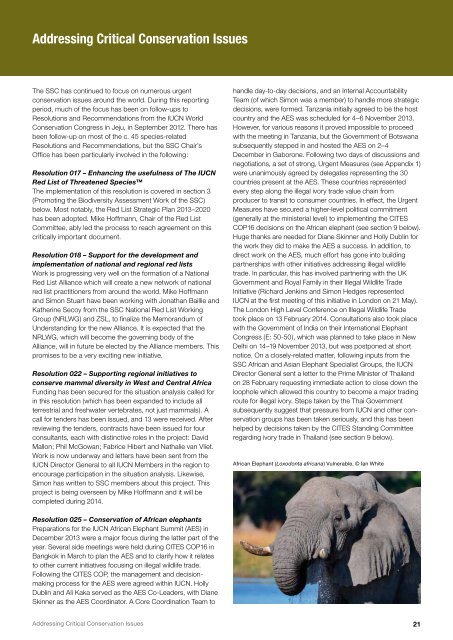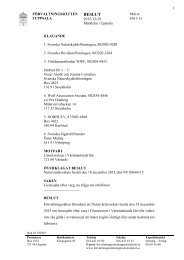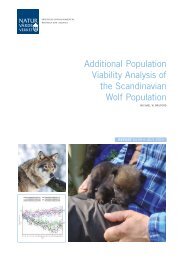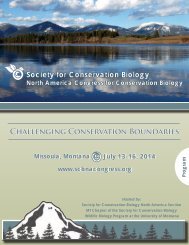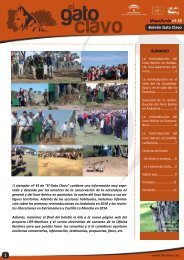1oC3Dbk
1oC3Dbk
1oC3Dbk
Create successful ePaper yourself
Turn your PDF publications into a flip-book with our unique Google optimized e-Paper software.
Addressing Critical Conservation Issues<br />
The SSC has continued to focus on numerous urgent<br />
conservation issues around the world. During this reporting<br />
period, much of the focus has been on follow-ups to<br />
Resolutions and Recommendations from the IUCN World<br />
Conservation Congress in Jeju, in September 2012. There has<br />
been follow-up on most of the c. 45 species-related<br />
Resolutions and Recommendations, but the SSC Chair’s<br />
Office has been particularly involved in the following:<br />
Resolution 017 – Enhancing the usefulness of The IUCN<br />
Red List of Threatened Species<br />
The implementation of this resolution is covered in section 3<br />
(Promoting the Biodiversity Assessment Work of the SSC)<br />
below. Most notably, the Red List Strategic Plan 2013–2020<br />
has been adopted. Mike Hoffmann, Chair of the Red List<br />
Committee, ably led the process to reach agreement on this<br />
critically important document.<br />
Resolution 018 – Support for the development and<br />
implementation of national and regional red lists<br />
Work is progressing very well on the formation of a National<br />
Red List Alliance which will create a new network of national<br />
red list practitioners from around the world. Mike Hoffmann<br />
and Simon Stuart have been working with Jonathan Baillie and<br />
Katherine Secoy from the SSC National Red List Working<br />
Group (NRLWG) and ZSL, to finalize the Memorandum of<br />
Understanding for the new Alliance. It is expected that the<br />
NRLWG, which will become the governing body of the<br />
Alliance, will in future be elected by the Alliance members. This<br />
promises to be a very exciting new initiative.<br />
Resolution 022 – Supporting regional initiatives to<br />
conserve mammal diversity in West and Central Africa<br />
Funding has been secured for the situation analysis called for<br />
in this resolution (which has been expanded to include all<br />
terrestrial and freshwater vertebrates, not just mammals). A<br />
call for tenders has been issued, and 13 were received. After<br />
reviewing the tenders, contracts have been issued for four<br />
consultants, each with distinctive roles in the project: David<br />
Mallon; Phil McGowan; Fabrice Hibert and Nathalie van Vliet.<br />
Work is now underway and letters have been sent from the<br />
IUCN Director General to all IUCN Members in the region to<br />
encourage participation in the situation analysis. Likewise,<br />
Simon has written to SSC members about this project. This<br />
project is being overseen by Mike Hoffmann and it will be<br />
completed during 2014.<br />
handle day-to-day decisions, and an Internal Accountability<br />
Team (of which Simon was a member) to handle more strategic<br />
decisions, were formed. Tanzania initially agreed to be the host<br />
country and the AES was scheduled for 4–6 November 2013.<br />
However, for various reasons it proved impossible to proceed<br />
with the meeting in Tanzania, but the Government of Botswana<br />
subsequently stepped in and hosted the AES on 2–4<br />
December in Gaborone. Following two days of discussions and<br />
negotiations, a set of strong, Urgent Measures (see Appendix 1)<br />
were unanimously agreed by delegates representing the 30<br />
countries present at the AES. These countries represented<br />
every step along the illegal ivory trade value chain from<br />
producer to transit to consumer countries. In effect, the Urgent<br />
Measures have secured a higher-level political commitment<br />
(generally at the ministerial level) to implementing the CITES<br />
COP16 decisions on the African elephant (see section 9 below).<br />
Huge thanks are needed for Diane Skinner and Holly Dublin for<br />
the work they did to make the AES a success. In addition, to<br />
direct work on the AES, much effort has gone into building<br />
partnerships with other initiatives addressing illegal wildlife<br />
trade. In particular, this has involved partnering with the UK<br />
Government and Royal Family in their Illegal Wildlife Trade<br />
Initiative (Richard Jenkins and Simon Hedges represented<br />
IUCN at the first meeting of this initiative in London on 21 May).<br />
The London High Level Conference on Illegal Wildlife Trade<br />
took place on 13 February 2014. Consultations also took place<br />
with the Government of India on their International Elephant<br />
Congress (E: 50-50), which was planned to take place in New<br />
Delhi on 14–19 November 2013, but was postponed at short<br />
notice. On a closely-related matter, following inputs from the<br />
SSC African and Asian Elephant Specialist Groups, the IUCN<br />
Director General sent a letter to the Prime Minister of Thailand<br />
on 28 February requesting immediate action to close down the<br />
loophole which allowed this country to become a major trading<br />
route for illegal ivory. Steps taken by the Thai Government<br />
subsequently suggest that pressure from IUCN and other conservation<br />
groups has been taken seriously, and this has been<br />
helped by decisions taken by the CITES Standing Committee<br />
regarding ivory trade in Thailand (see section 9 below).<br />
African Elephant (Loxodonta africana) Vulnerable. © Ian White<br />
Resolution 025 – Conservation of African elephants<br />
Preparations for the IUCN African Elephant Summit (AES) in<br />
December 2013 were a major focus during the latter part of the<br />
year. Several side meetings were held during CITES COP16 in<br />
Bangkok in March to plan the AES and to clarify how it relates<br />
to other current initiatives focusing on illegal wildlife trade.<br />
Following the CITES COP, the management and decisionmaking<br />
process for the AES were agreed within IUCN. Holly<br />
Dublin and Ali Kaka served as the AES Co-Leaders, with Diane<br />
Skinner as the AES Coordinator. A Core Coordination Team to<br />
Addressing Critical Conservation Issues<br />
21


